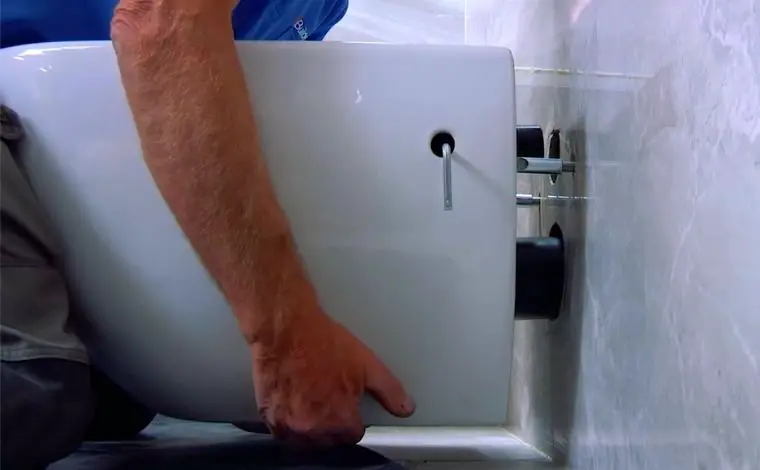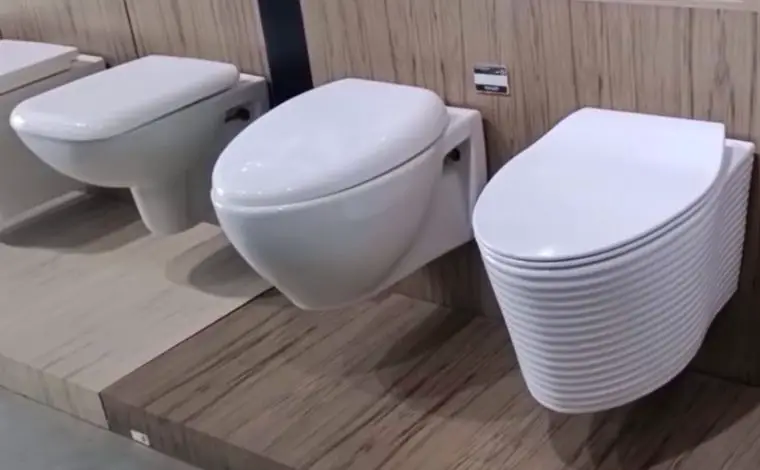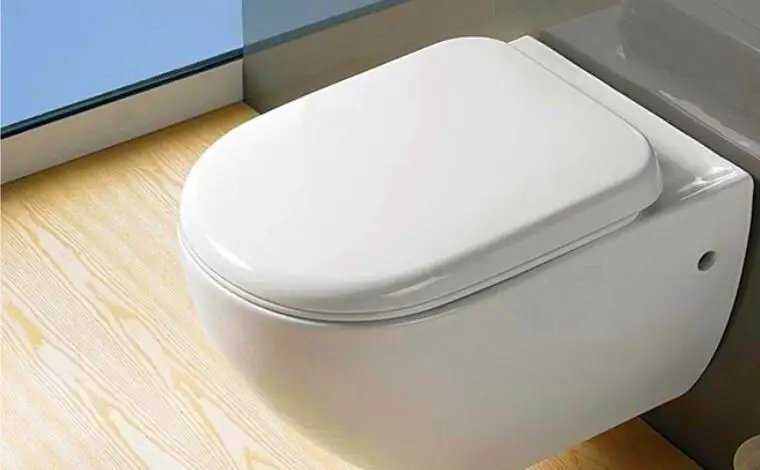Choosing a toilet might seem like a simple decision, but it can significantly affect your bathroom’s comfort, safety, and longevity. With modern home designs favoring sleek lines and minimalist styles, wall-mounted toilets have become one of the most desired choices. They not only save space and look stylish but also make cleaning effortless.
However, one important question often remains overlooked—how much weight can a wall-mounted toilet hold? Understanding its carrying capacity and weight limit is crucial to ensure both safety and durability.
Let’s explore this topic in depth, uncovering how these toilets are designed, their real-world weight limits, pros and cons, and tips to choose the perfect one for your home.
Some of the best wall-mounted toilets are-
What Is a Wall-Mounted Toilet?
A wall-mounted toilet (also known as a wall-hung toilet) is a modern type of commode attached directly to the bathroom wall instead of resting on the floor. The tank and flushing system are concealed inside the wall, leaving only the bowl and flush plate visible.
This design saves space, looks elegant, and allows the floor underneath to remain completely open—making cleaning easier.
Wall-mounted toilets are installed using a steel carrier frame system fixed inside the wall, which bears the entire weight of the user and the toilet itself. These frames are carefully engineered to hold hundreds of pounds safely.
Why Weight Limit Matters
Unlike traditional toilets that rest firmly on the ground, a wall-mounted toilet appears to “float” above the floor. Because of this design, all the user’s weight is transferred to the in-wall carrier system. If the toilet or carrier is not designed to handle sufficient load, it could result in cracking, detachment, or even injury.
Understanding the weight-carrying limit helps you:
-
Choose the right model for your household’s needs
-
Avoid structural or plumbing damage
-
Ensure long-term reliability and safety
Standard Weight Capacity of Wall-Mounted Toilets
According to the ASME A112.19.2/CSA B45.1 standard, wall-mounted toilets must support at least 500 pounds (226.8 kg) of static weight. This standard is mandatory for any toilet sold in the United States and Canada.
That means every certified wall-mounted commode—whether from TOTO, Kohler, Duravit, or other leading brands—can safely hold at least that much weight when properly installed.
However, high-end models can handle even more:
| Brand & Model | Maximum Weight Capacity | Notable Feature |
|---|---|---|
| TOTO Aquia Wall-Hung Dual Flush | 880 lbs (400 kg) | Industry’s highest load capacity |
| Kohler Veil K-6299-NY Smart Toilet | 500 lbs (226 kg) | Compact and modern design |
| Duravit DuraStyle Wall-Mounted Toilet | 700 lbs (317 kg) | German engineering and durability |
| Geberit DuoFix Carrier System | 880 lbs (400 kg) | Reinforced steel carrier frame |
These toilets easily accommodate the vast majority of users, including heavier individuals.
How Do Wall-Mounted Toilets Support the Weight?
It might be hard to believe that a toilet attached to a wall can safely hold the weight of an adult, but the engineering behind it is impressive. Let’s break down how it works.
1. The Hidden Steel Carrier Frame
Behind the wall sits a heavy-duty steel frame anchored to both the wall studs and the floor. The toilet bowl connects to this frame, not to the wall surface itself. This means the load is distributed vertically and horizontally into the structural framework, ensuring maximum strength.
2. Wall Reinforcement
The frame is usually installed inside a 2×6 stud wall or a solid masonry wall. During installation, the plumber reinforces the area with additional studs, ensuring the structure can withstand more than 800 pounds of static load.
3. Anchor Bolts and Mounting Plates
Long, thick anchor bolts connect the toilet bowl to the frame through the wall. These bolts bear the user’s weight, keeping the toilet stable and secure.
4. The Role of Proper Installation
Even a strong carrier system can fail if installed incorrectly. For long-term safety, it’s essential that a licensed plumber handles installation, following both manufacturer guidelines and local building codes.
Are Wall-Mounted Toilets Safe for Heavy People?
Yes—absolutely. Wall-mounted toilets are specifically designed to hold more than twice the average adult weight.
Let’s look at some average figures:
-
Average American man: 196 pounds (89 kg)
-
Average American woman: 166 pounds (75 kg)
-
Wall-mounted toilet weight limit: 500–880 pounds
This means that even heavier individuals are well within the safe range, especially with high-capacity models.
For those with obesity or limited mobility, choosing a reinforced carrier frame such as the Geberit Duofix or TOTO in-wall system adds an extra layer of safety.
Recommended Dimensions and Installation Height
Proper dimensions and installation height ensure comfort, safety, and compliance with code requirements.
1. Height
-
Standard height: ~15 inches from the floor to the top of the seat
-
Comfort height: 17–19 inches (ideal for seniors or tall individuals)
Because wall-mounted toilets allow height customization, they are particularly suitable for families where members vary in height.
2. Clearance and Spacing
-
15 inches minimum clearance from the center of the toilet to any side wall
-
30 inches minimum clearance between the centers of adjacent fixtures
-
24 inches of free space in front of the toilet for comfortable access
These measurements are typically required by building codes such as the International Plumbing Code (IPC).
Structural Requirements Before Installation
Before installing a wall-mounted toilet, check these conditions:
-
Wall Type: Concrete or reinforced stud wall (not hollow drywall).
-
Stud Depth: A 2×6 wall cavity is ideal for housing the tank and carrier.
-
Floor Anchoring: The base of the frame must be bolted into the subfloor for stability.
-
Weight Distribution: Ensure the carrier system evenly distributes the load across multiple studs.
If your existing wall doesn’t meet these conditions, your contractor can add a reinforcement bracket or plywood backing to handle the load safely.
Advantages of Wall-Mounted Toilets
Wall-mounted toilets offer numerous benefits beyond aesthetics. They’re designed to make daily use more comfortable, hygienic, and modern.
Elegant Appearance
Their clean lines, hidden tank, and floating bowl create a modern spa-like vibe in your bathroom. They make even small spaces appear larger and more sophisticated.
Easy to Clean
Since there’s no base touching the floor, cleaning underneath becomes simple. You can easily mop or vacuum without bending awkwardly, which keeps your bathroom more hygienic.
Adjustable Height for Comfort
You can mount the toilet bowl at any height—from standard to comfort level—so every family member enjoys the right seating position. This customization also reduces knee strain for elderly users.
Saves Floor Space
By concealing the tank inside the wall, wall-mounted toilets save up to 10 inches of floor space. This makes them ideal for compact bathrooms and apartments.
Reduced Noise
Since the tank is hidden behind the wall, flushing noise is significantly reduced. It’s perfect for nighttime use in shared living spaces.
Disadvantages of Wall-Mounted Toilets
Despite their premium look and advanced design, wall-mounted toilets come with a few downsides that buyers should consider.
Higher Cost
The total cost of a wall-mounted toilet setup is considerably higher than that of a standard floor-mounted toilet. The toilet bowl, in-wall tank, and carrier frame can cost $1,000–$2,000, and installation may add another $500–$1,500 depending on your plumbing setup.
Difficult Maintenance
Because the tank and flushing mechanism are hidden behind the wall, access for maintenance can be challenging. However, modern models feature removable flush plates that allow limited but practical access to internal components.
Complex Installation
Installation requires wall reinforcement, plumbing modification, and precise measurement. This process is not DIY-friendly and usually demands professional expertise.
Risk of Improper Setup
If not installed correctly, the toilet may feel unstable or even detach over time. Always use a certified carrier system and follow the manufacturer’s torque specifications.
Types of Wall-Mounted Toilets
There are two main types based on how the flushing system is configured.
1. In-Tank System
The in-tank wall-mounted toilet has a built-in water tank within the ceramic bowl itself. It’s easy to install and ideal for remodels where wall space is limited.
Pros: Compact, straightforward installation
Cons: Smaller water capacity, harder to repair
2. Concealed Cistern System
This is the most common setup, where the tank and carrier frame are hidden behind the wall, leaving only the flush plate and bowl visible.
Pros: Stylish look, quieter flushing, higher capacity
Cons: Costlier and more complex to install
Why Western Countries Need Heavy-Duty Wall-Mounted Toilets
Obesity rates are increasing across North America and Europe. According to CDC data, over 42% of American adults are obese. This has pushed manufacturers to develop stronger toilet systems that can bear heavier loads safely.
Modern heavy-duty wall-mounted toilets, such as those from TOTO or Geberit, now handle up to 880 pounds, giving users confidence and comfort.
These systems are not just for residential use—commercial spaces like hospitals, hotels, airports, and gyms also prefer wall-mounted toilets for hygiene, accessibility, and modern design. The higher weight capacity ensures they can serve all users reliably, regardless of size.
Maintenance Tips to Ensure Durability
Proper maintenance is essential to make your wall-mounted toilet last for decades.
-
Inspect Bolts Annually: Tighten loose bolts to prevent wobbling.
-
Clean with Mild Detergents: Avoid harsh chemicals that can damage ceramic glaze.
-
Don’t Stand or Sit on the Lid: Wall-mounted toilets are strong, but not designed to carry extra pressure on the lid.
-
Flush Regularly: Avoid long periods without use to prevent water seal drying.
-
Check for Leaks: Look behind the flush plate occasionally for moisture or condensation.
With proper care and installation, most wall-mounted toilets can last 40–50 years, while the carrier frame often comes with a 25-year warranty.
How to Choose the Right Wall-Mounted Toilet
Selecting the right wall-hung toilet involves more than just style. You must consider weight, comfort, space, and maintenance requirements.
-
Weight Capacity: Choose models with at least 500 lbs capacity—preferably 700–880 lbs for extra safety.
-
Frame Brand Compatibility: Ensure the toilet bowl matches the frame (e.g., TOTO bowl + TOTO frame).
-
Height Preference: Install at a comfortable height for all family members.
-
Wall Strength: Reinforce drywall with plywood or steel studs if needed.
-
Budget: Expect to spend between $1,200–$2,500 for a complete setup.
-
Warranty: Reputable brands often provide 10–25-year warranties on frames and ceramic parts.
Myths About Wall-Mounted Toilets
Many homeowners hesitate to install wall-hung toilets due to misconceptions. Let’s clear them up.
Myth 1: They can fall off the wall easily.
Fact: When installed correctly using a certified frame, they are as strong as—or stronger than—floor-mounted toilets.
Myth 2: They’re only for luxury bathrooms.
Fact: Affordable wall-hung models are available today, making them suitable for average homes too.
Myth 3: Repairs require breaking the wall.
Fact: Most maintenance can be done through the flush plate opening without damaging tiles or walls.
Myth 4: They’re not suitable for heavy users.
Fact: Certified systems can carry up to 880 lbs—safe for almost all users.
Environmental and Design Benefits
Besides aesthetics and comfort, wall-mounted toilets also contribute to sustainability. Their dual-flush technology helps conserve water by using only 0.8–1.6 gallons per flush, depending on waste type.
Moreover, their compact design allows architects to design smaller, efficient bathrooms—reducing material use and construction costs in large housing projects.
Real-World Example: TOTO Aquia Wall-Hung Toilet
The TOTO Aquia Dual Flush Wall-Hung Toilet is a benchmark in the market. It’s engineered with a robust carrier frame and can handle 880 pounds of weight. Its sleek design conceals the tank and features a dual-flush mechanism (0.9 and 1.6 GPF) for water savings.
Homeowners love it for its reliability, quiet operation, and luxurious look. Its reinforced ceramic bowl and stainless steel frame make it ideal for both residential and commercial use.
Final Thoughts
The carrying capacity and weight limit of a wall-mounted toilet are essential factors for long-term safety and comfort. With modern designs and robust frames, these toilets are not just beautiful but incredibly strong.
-
Standard models can hold 500 lbs, while premium versions can handle up to 880 lbs.
-
Proper installation and reinforced walls ensure decades of reliable use.
-
They save space, simplify cleaning, and offer unmatched aesthetic appeal.
However, manufacturers should continue improving in two areas—increasing weight capacity and reducing overall cost—to make wall-mounted toilets accessible to every household.
If you’re planning to upgrade your bathroom, investing in a high-quality wall-mounted toilet with a certified in-wall carrier system will give you a blend of modern luxury, hygiene, and safety for years to come.
Hi, this is Robert Crossan, the owner of this website, has 17 years of experience in the installation, maintenance, and repair of toilets and plumbing systems. After completing the Level 2 Basic Plumbing course in 2005, I started working in both domestic and commercial buildings as a professional plumber. So I can figure out the core difference between different toilet models and brands. It also helped me monitor their work performance and setbacks.